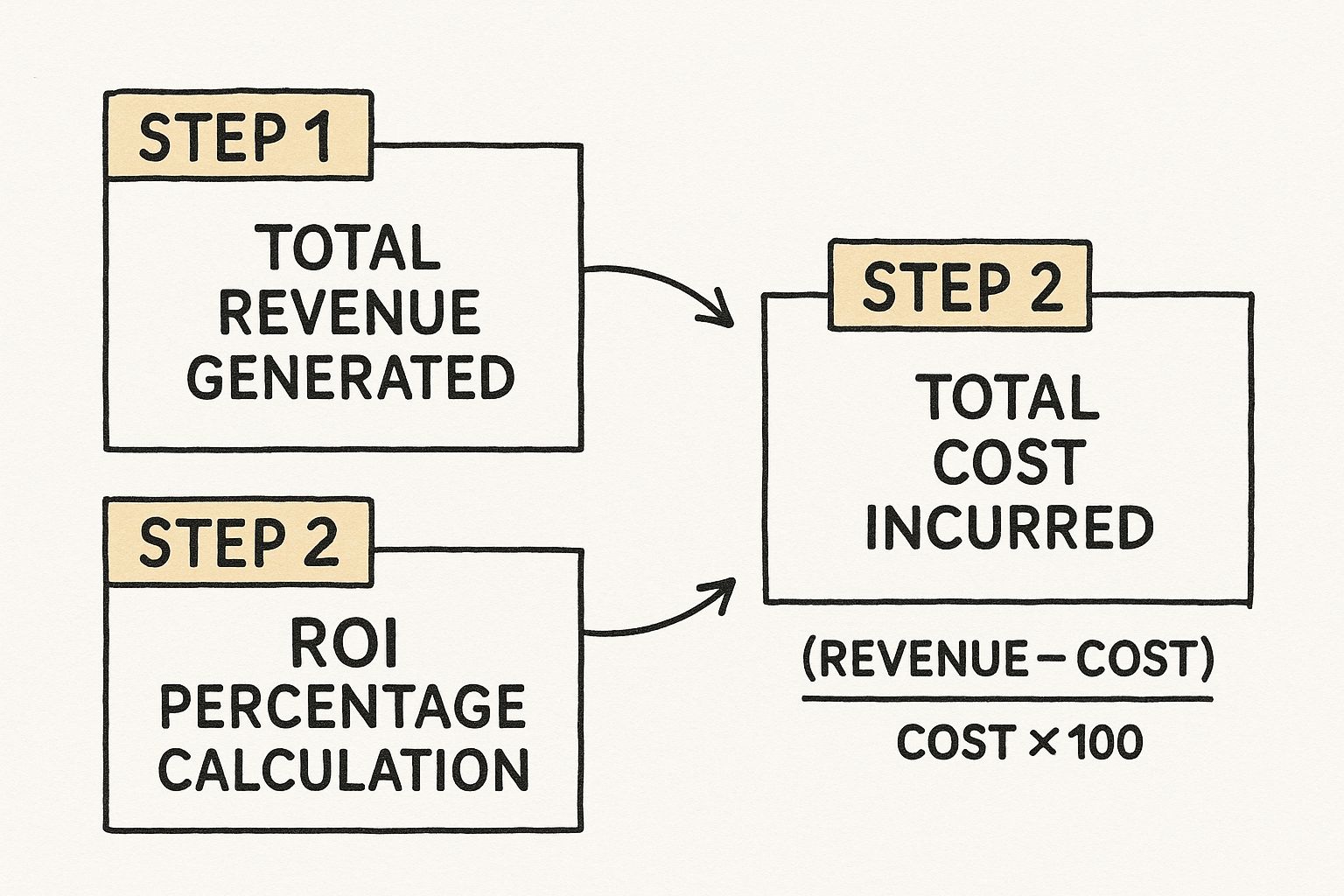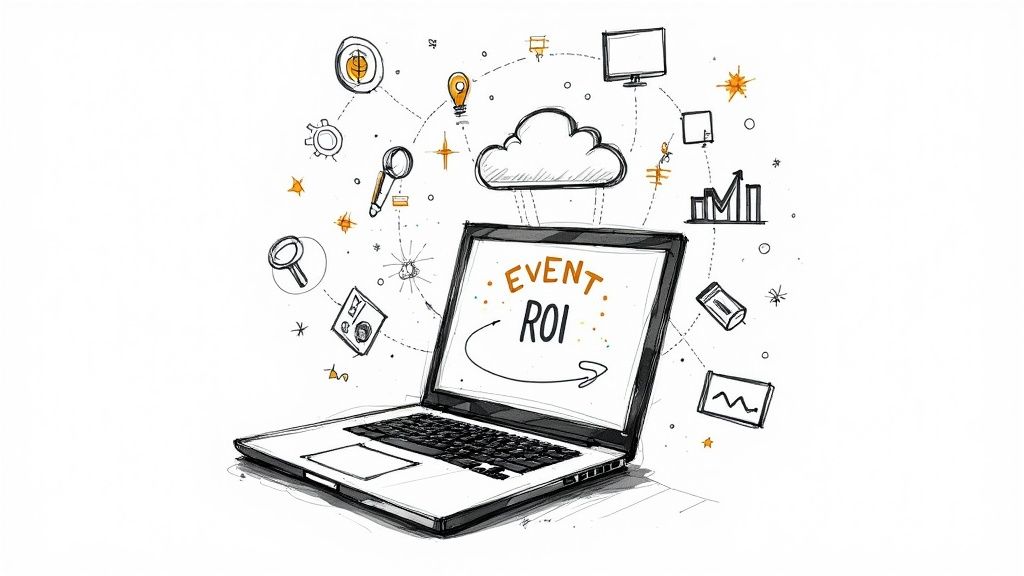August 2, 2025

Measuring the return on investment (ROI) for an event is so much more than just looking at ticket sales and subtracting your expenses. If you want to grasp the real value your event delivered, you need to look at the whole picture—things like brand lift, lead generation, and building long-term customer loyalty.
This modern way of thinking shifts the focus from a single, simple financial number to a complete story of business growth.
If you're only counting revenue, you're missing the most important chapters of your event's story. I always tell my clients to think of an event not as a standalone expense, but as a serious investment in marketing and relationship-building. Its success sends ripples across your entire organization, touching everything from sales and marketing to customer retention, long after the final session has wrapped.
The trick is to have a framework that actually captures this full-circle impact. This means leaving outdated, surface-level metrics behind and embracing a more holistic view. The true return is a mix of hard financial wins and those powerful, less direct benefits that strengthen your business for the long haul.
A great event creates value in so many ways that are crucial for sustainable growth. To really start measuring event ROI effectively, you have to account for these core areas:
The most insightful ROI calculations I've seen blend financial data with qualitative wins. An event that just breaks even on cost but generates a dozen high-value sales leads and creates significant positive buzz is, in my book, a massive success.
The challenge of measuring ROI gets even trickier when you're running global events. These gatherings bring together diverse audiences with different cultural expectations and wildly varying market conditions. A one-size-fits-all measurement approach is doomed to fail.
The strategy that works wonders for a local trade show in North America simply won't capture the full picture of a multinational user conference in Asia. To get it right, you need a methodology flexible enough to account for these regional nuances and give you a true estimate of your return. You can learn more about overcoming these global challenges from industry experts.
To tie this all together, think about event success through a modern lens. The table below breaks down the key pillars that define a truly successful event in today's world.
Ultimately, a comprehensive approach gives you the clarity to prove your event's value to stakeholders and, more importantly, provides the insights you need to make your next event even better.

Before you can even think about measuring event ROI, you need a clear destination. It’s a classic mistake. Trying to calculate success without first defining what it looks like is like starting a road trip with no map—you’ll be moving, sure, but you'll have no idea if you're actually getting anywhere.
The foundation of any solid ROI report is a set of clear, quantifiable objectives. And these need to be set before the real event planning kicks into high gear.
I've seen it a thousand times: vague goals like "increase brand awareness" or "improve networking." While well-intentioned, they're practically impossible to measure effectively. They just don't have the teeth to guide your strategy or, more importantly, prove your event's value to stakeholders. The trick is to translate these broad ambitions into tangible outcomes that tie directly back to the business's bottom line.
So, how do you turn a fuzzy goal into something you can actually measure? It starts with asking the right questions. Instead of settling for "brand awareness," ask yourself, "What does increased awareness actually look like for our company?" This simple reframe forces you to identify concrete Key Performance Indicators (KPIs) that will become your yardsticks for success.
Let's say you're planning a product launch event. The main goal is to generate market buzz. Here’s how you can make that measurable by setting specific, ambitious targets:
Suddenly, you have real numbers to aim for and report on. Each KPI is a clear signal, telling you whether the event hit the mark and making your ROI calculation far more straightforward and defensible.
It’s also critical to remember that not all events are created equal. The right goals will shift dramatically depending on the type of event you're hosting. The objectives for an internal sales kick-off are worlds apart from those of a massive user conference.
Let's walk through a couple of real-world scenarios:
1. Annual User Conference
Here, a major goal is almost always customer retention and finding upsell opportunities. Your objectives might look like this:
2. Internal Sales Kick-Off
For an internal event, the focus shifts to team enablement and motivation. Your measurable goals could include:
The most powerful event goals are those that directly support a broader business priority. If the company's Q3 focus is breaking into a new market, your event's primary goal should be to generate qualified leads from that specific region.
By defining these sharp, actionable goals from the very beginning, you’re essentially creating a blueprint for success. This plan not only guides every strategic decision you make for the event but also ensures you're collecting the right data from day one. When it's time to build your post-event report, you won't be scrambling to find metrics to justify the spend. Instead, you'll have a clear, compelling story of achievement backed by hard numbers.

Alright, you've set your goals. Now comes the fun part: gathering the raw material to prove your event’s worth. The data. The tools and methods you pick here are everything; they directly impact how accurately you can measure your event ROI. Your tech stack doesn't need to break the bank, but it absolutely must be chosen with intention.
What works best really boils down to your event type, your budget, and those KPIs you just figured out. For a small, intimate workshop, a simple post-event survey sent via a tool like SurveyMonkey might be all you need. But for a massive hybrid conference? You'll need a much more sophisticated system to capture data from people both in the room and behind a screen.
For live, in-person events, tracking attendee behavior has moved way beyond simple headcounts. Modern tech lets you see what really clicked with your audience.
These aren't just fancy gadgets; they turn vague observations like "that booth seemed busy" into concrete numbers that prove which parts of your event drove the most engagement.
Virtual and hybrid events are a goldmine of data. The digital footprint is massive, offering incredible opportunities for measuring ROI. The trick is using an event platform with powerful, built-in analytics.
Good event management software automatically tracks the metrics that matter. You can see not just who attended a session, but for how long. Did they ask questions in the Q&A? Did they vote in the live polls? This is the granular data you want. For instance, if you can show that 70% of attendees who watched the product demo also visited the virtual sponsor booth, you have a powerful story to tell.
The best strategies don't rely on a single tool. Combine your event platform for digital engagement stats, surveys for qualitative feedback, and your CRM to track post-event sales conversions. This creates a much richer, multi-touch view of your event's true impact.
Don't forget about tracking your marketing, either. By using unique tracking links for your different promotional channels (email campaigns, social media ads, partner websites), you can see exactly where your registrations came from. This tells you which marketing dollars worked the hardest. When you have this kind of detailed data, it also makes it much easier to show value when you're figuring out how to get a sponsor.
Ultimately, you're building a tech stack that works for your goals. By mixing the right tools—from simple surveys to advanced event platforms—you'll collect the specific data you need to build a compelling ROI report that reflects your event's total value.
Even with all the modern ways we look at event success, let's be honest: the numbers still matter. A lot. When you're standing in front of your leadership team, a solid financial calculation is the bedrock of your report. It gives everyone a clear, objective baseline for what was achieved.
It all boils down to one surprisingly simple formula.
(Net Profit / Total Event Cost) x 100 = ROI %
This little equation gives you a clean percentage, showing the return for every dollar you put in. A positive ROI means you're in the black; a negative one means you've got some explaining to do. The real magic, of course, isn't in the formula itself, but in how accurately you track down the numbers that go into it.
This infographic breaks down the basic flow of the calculation.

Think of it as your financial map: you combine all your revenue sources and subtract all your costs to get that final ROI percentage—the key metric that proves your event was a sound investment.
First, you have to get ruthlessly honest about every single dollar spent. This number, what some people call the Total Investment, is always more than just the big, obvious expenses. I've seen too many event pros miss the small stuff, which can really skew the final picture.
A complete accounting needs to include:
Having access to this data in real-time is a game-changer. The pressure to prove a clear ROI is immense, pushing many companies to finally invest in better analytics. You can explore this trend in event management to see how technology is making financial tracking more precise than ever.
Next up is the fun part: tallying up the money your event brought in. This is about more than just ticket sales. Your Gross Revenue should capture every income stream, from high-value sponsorships and exhibitor fees right down to merchandise sales.
Once you have your Gross Revenue and Total Event Cost, finding your Net Profit is simple arithmetic:
Gross Revenue - Total Event Cost = Net Profit
Let's walk through a quick example. Imagine you just wrapped up a B2B tech conference.
Now, we plug those numbers back into our main ROI formula:
This number tells a fantastic story. You can confidently report that for every single dollar invested, the event generated a return of nearly 88 cents. That's a win.
But what about the long game? A truly savvy financial analysis doesn't just stop at the event's closing day. This is where a powerful metric called Customer Lifetime Value (CLV) comes into play. CLV is essentially a forecast of the total profit you can expect from a new customer over the entire course of their relationship with your company.
Let's say your conference brought in 20 hot new leads who converted into paying customers. If your average customer has a CLV of $5,000, you can attribute $100,000 in future value directly to the event.
Adding this future value to your ROI calculation gives you a much more compelling, holistic view of your event's long-term impact. It’s the difference between showing a good result and showing a truly strategic one.
The numbers from your financial formulas tell a vital part of the story, but they can't tell you why an attendee loved a specific session or what part of the experience they’ll be talking about for weeks. To truly measure an event's impact, you have to look beyond the spreadsheet and capture those intangible wins that build lasting brand loyalty. This is where qualitative data shines.
This "softer" data—the real human feedback from post-event surveys, social media conversations, and one-on-one chats—is your secret weapon. You can't plug a heartfelt comment into a calculator, but you can absolutely analyze this information to measure things like brand perception, attendee satisfaction, and the strength of the new relationships forged at your event.
First things first, you need a smart way to gather and sort through all that feedback. Open-ended survey questions are a goldmine here. Don't just ask attendees to rate a workshop on a scale of 1 to 5; ask them why they gave that score. What did they love? What could have been better?
Once you have this treasure trove of text, you can start coding it. This isn't as technical as it sounds. It simply means reading through the responses and grouping them into common themes. As you go, you’ll start to see patterns emerge. You might create categories like:
By counting the comments in each category, you turn subjective opinions into solid data. Now you can report with confidence that 45% of attendees specifically highlighted the quality of the networking opportunities—a powerful non-financial return.
The real magic of qualitative analysis isn’t just counting comments. It's about uncovering the ‘why’ behind the numbers. That insight is what allows you to make brilliant decisions for your next event, so you can double down on what people loved and fix what fell flat.
Your event’s influence doesn't stop when the doors close. It ripples out into the industry, shaping how people see your brand. Social media is the perfect listening post to measure this.
You can use a sentiment analysis tool to track your event hashtag and brand mentions, gauging the overall tone of the conversation. These tools automatically classify posts as positive, negative, or neutral, giving you a clear metric for brand lift. Imagine showing your stakeholders a report that proves a 75% positive sentiment during your event week—that’s a huge win.
Don't stop there. Combine this with data on media mentions and press coverage. Did key industry publications write about your event? Was the coverage favorable? This all paints a complete picture of how your event boosted your brand's reputation. For a deeper look at this, our guide on how to measure event success offers even more strategies.
Ultimately, the most compelling ROI report blends hard financial data with these crucial non-financial returns. This holistic approach gives stakeholders the full story, proving your event wasn't just profitable, but a strategic investment in your brand’s future.

Virtual and hybrid events have completely changed the game. It’s not just about planning differently; it’s about having a massive new opportunity to measure your event's success with pinpoint accuracy. These events create a treasure trove of digital data, but you have to know what you're looking for.
The real trick is to stop obsessing over basic attendance numbers. Instead, we need to dig into the specific engagement behaviors that only a digital environment can show us. It's about tapping into the digital footprint every single attendee leaves behind.
We’re talking about a level of detail we could only dream of with purely in-person events. Think about tracking how long someone watches a specific session, how many people download a resource, or who participates in a live chat. Each of these is a solid data point that paints a clear picture of what your audience cares about. Once you get good at collecting this information, you get a much sharper, more honest view of your event's true impact.
The true strength of a virtual event platform is its ability to track what attendees actually do, not just that they logged on. This granular behavioral data is your secret weapon for proving value to sponsors and leadership.
Here’s what I focus on:
Expert Tip: Hybrid events are a fantastic A/B test. You can directly compare the engagement of your in-person audience to your virtual one. This gives you incredible insight into what content and delivery methods work best for each group.
When you look at the numbers, the case for virtual and hybrid events gets even more compelling, and it directly feeds into your ROI calculation. On average, a virtual event can cost 75% less to produce than a physical one. At the same time, we've seen them boost lead capture by up to 30%.
The financial benefits are undeniable— 81% of companies say they see a higher ROI from their online events. When you combine dramatically lower overhead with more effective lead generation, you've got a recipe for success.
Imagine being able to report that your virtual attendees spent 27% more time engaged with content compared to your last in-person event. That’s a powerful, data-backed statement. It turns a simple financial report into a strategic analysis of audience behavior, which is exactly what you need for effective event marketing strategies. By leaning into these modern formats, you're not just saving a bit of budget; you're gaining the kind of deep insights that will make every future event even better.
Even seasoned event professionals run into the same roadblocks when it comes to measuring ROI. Let's tackle some of the most common questions I hear, because getting these right is what separates a good event from a great one.
When it's time to talk budget with leadership, you have to speak their language. They aren't just looking at costs; they're looking for smart investments. So, don't just hand them a spreadsheet of expenses versus ticket sales.
Instead, tell a story with your data. Frame your ROI in terms that resonate with the C-suite, like customer acquisition cost (CAC). I’ve seen this work wonders. For instance, you could show that acquiring a new customer through your conference was 20% cheaper than your company's average digital marketing spend. Suddenly, your event isn't an expense—it's one of the most efficient growth drivers you have.
This is a big one, especially for B2B events where sales cycles can feel like a marathon. Measuring your impact just a week after the event is like leaving the theater halfway through the movie; you'll miss the whole point.
The real value of an event often unfolds over months, not days. Make sure your CRM is set up to tag every lead from the event. Then, you can watch their journey for the next six to twelve months. This is how you connect the dots between a handshake at your booth and a signed contract down the line.
Without that long-term view, you're leaving a huge chunk of your event's success story untold.
Yes, absolutely. You don't need a massive software budget to track ROI effectively. For small businesses or teams just starting out, it’s all about being clever and resourceful.
You can get surprisingly far with a few simple, often free, tools:
Focus on a handful of key metrics that truly matter—like qualified leads generated or attendee satisfaction scores. This approach gives you the hard data you need to prove your event's worth without breaking the bank.
Ready to streamline your event management and get the data you need to prove your success? GroupOS is an all-in-one platform that helps you manage registrations, track engagement, and deliver powerful analytics, so you can measure event ROI effortlessly. Start your free trial and see how GroupOS can help you grow.


